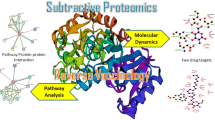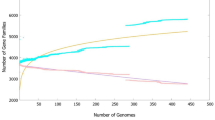Abstract
Leprosy is caused by Mycobacterium leprae a major health concern in several countries of the world particularly in Asia and Africa. The preventive measurement has been adopted by the combined efforts of the leprosy burden countries and WHO. However, the situation is getting worse due to the emergence of the resistant strains of the M. leprae. The continuous efforts are underway to discover new chemical agent as a therapeutic to cure the diseases caused by the resistant pathogens of bacterial origins. The resistant pathogens are still growing on alarming rate. In order to overcome the resistant pathogens, a relatively newer approach has been applied since last decade. One of them involves the computational subtractive genomics, in which the complete proteome of the bacterial pathogen is step-wise reduced to few potential drug targets. The steps include the finding of non-host proteins, essentiality of the proteins to the pathogens and involvement of the shortlisted proteins in essential metabolic pathways of the pathogen, which are necessary for the bacterial survival. In the current study, we applied computational subtractive genomics on complete proteome of the M. leprae and ended up with 16 hypothetical proteins as potential drug targets against which new active molecules can be proposed to ameliorate the activity to cure the disease associated with them. The study is innovative and has a potential to improve the research directions in unraveling the novel cure of leprosy.




Similar content being viewed by others
References
Altschul SF, Gish W, Miller W, Myers EW, Lipman DJ (1990) Basic local alignment search tool. J Mol Biol 215:403–410
Barh D, Tiwari S, Jain N, Ali A, Santos AR, Misra AN, Azevedo V, Kumar A (2011) In silico subtractive genomics for target identification in human bacterial pathogens. Drug Dev Res 72:162–177
Cai C, Han L, Ji ZL, Chen X, Chen YZ (2003) SVM-Prot: web-based support vector machine software for functional classification of a protein from its primary sequence. Nucleic Acids Res 31:3692–3697
Cole S (2002) Comparative mycobacterial genomics as a tool for drug target and antigen discovery. Eur Respir J Suppl 20:78s–86s
Cole S, Eiglmeier K, Parkhill J, James K, Thomson N, Wheeler P, Honore N, Garnier T, Churcher C, Harris D (2001) Massive gene decay in the leprosy bacillus. Nature 409:1007–1011
Crowther GJ, Shanmugam D, Carmona SJ, Doyle MA, Hertz-Fowler C, Berriman M, Nwaka S, Ralph SA, Roos DS, Van Voorhis WC (2010) Identification of attractive drug targets in neglected-disease pathogens using an in silico approach. PLoS Negl Trop Dis 4:e804
Jacobson R, Hastings R (1976) Rifampin-resistant leprosy. Lancet 308:1304–1305
Ji B, Perani EG, Petinom C, Grosset JH (1996) Bactericidal activities of combinations of new drugs against Mycobacterium leprae in nude mice. Antimicrob Agents Chemother 40:393–399
Knox C, Law V, Jewison T, Liu P, Ly S, Frolkis A, Pon A, Banco K, Mak C, Neveu V (2011) DrugBank 3.0: a comprehensive resource for ‘omics’ research on drugs. Nucleic Acids Res 39:D1035–D1041
Li W, Godzik A (2006) Cd-hit: a fast program for clustering and comparing large sets of protein or nucleotide sequences. Bioinformatics 22:1658–1659
Marri PR, Bannantine JP, Golding GB (2006) Comparative genomics of metabolic pathways in Mycobacterium species: gene duplication, gene decay and lateral gene transfer. FEMS Microbiol Rev 30:906–925
Matsuoka M, Suzuki Y, Garcia IE, Fafotis-Morris M, Vargas-Gonzalez A, Carreno-Martinez C, Fukushima Y, Nakajima C (2010) Possible mode of emergence for drug-resistant leprosy is revealed by an analysis of samples from Mexico. Jpn J Infect Dis 63:412–416
Moriya Y, Itoh M, Okuda S, Yoshizawa AC, Kanehisa M (2007) KAAS: an automatic genome annotation and pathway reconstruction server. Nucleic Acids Res 35:W182–W185
Nancy YY, Wagner JR, Laird MR, Melli G, Rey S, Lo R, Dao P, Sahinalp SC, Ester M, Foster LJ (2010) PSORTb 3.0: improved protein subcellular localization prediction with refined localization subcategories and predictive capabilities for all prokaryotes. Bioinformatics 26:1608–1615
Pettit J, Rees R (1964) Sulphone resistance in leprosy: an experimental and clinical study. Lancet 284:673–674
Sarker M, Talcott C, Galande AK (2013) In silico systems biology approaches for the identification of antimicrobial targets. Methods Mol Biol 993:13–30
Singh Y, Kohli S, Sowpati DT, Rahman SA, Tyagi AK, Hasnain SE (2014) Gene cooption in Mycobacteria and search for virulence attributes: comparative proteomic analyses of Mycobacterium tuberculosis, Mycobacterium indicus pranii and other mycobacteria. Int J Med Microbiol 304:742–748
Uddin R, Saeed K (2014) Identification and characterization of potential drug targets by subtractive genome analyses of methicillin resistant Staphylococcus aureus. Comput Biol Chem 48:55–63
Uddin R, Saeed K, Khan W, Azam SS, Wadood A (2015) Metabolic pathway analysis approach: identification of novel therapeutic target against methicillin resistant Staphylococcus aureus. Gene 556:213–226
Wurst H, Kornberg A (1994) A soluble exopolyphosphatas e of Saccharomyces cerevisiae. purification and characterization. J Biol Chem 269:10996–11001
Zhang R, Ou HY, Zhang CT (2004) DEG: a database of essential genes. Nucleic Acids Res 32:D271–D272
Acknowledgments
We acknowledge the International Foundation for Sciences (IFS) for providing the research grant.
Author information
Authors and Affiliations
Corresponding author
Ethics declarations
Conflict of interest
The authors report no conflict of interest, and they are responsible for the content and writing of the paper.
Electronic supplementary material
Below is the link to the electronic supplementary material.
File S1
Complete PSORT results (PDF 386 kb)
File S2
Functional annotation of non-homologous, essential and hypothetical proteins of M. leprae (PDF 47 kb)
File S3
Essential non-homologous proteins in M. leprae involved in different metabolic pathways and other cellular activities (obtained from KAAS) (PDF 77 kb)
Rights and permissions
About this article
Cite this article
Uddin, R., Azam, S.S., Wadood, A. et al. Computational identification of potential drug targets against Mycobacterium leprae . Med Chem Res 25, 473–481 (2016). https://doi.org/10.1007/s00044-016-1501-6
Received:
Accepted:
Published:
Issue Date:
DOI: https://doi.org/10.1007/s00044-016-1501-6




